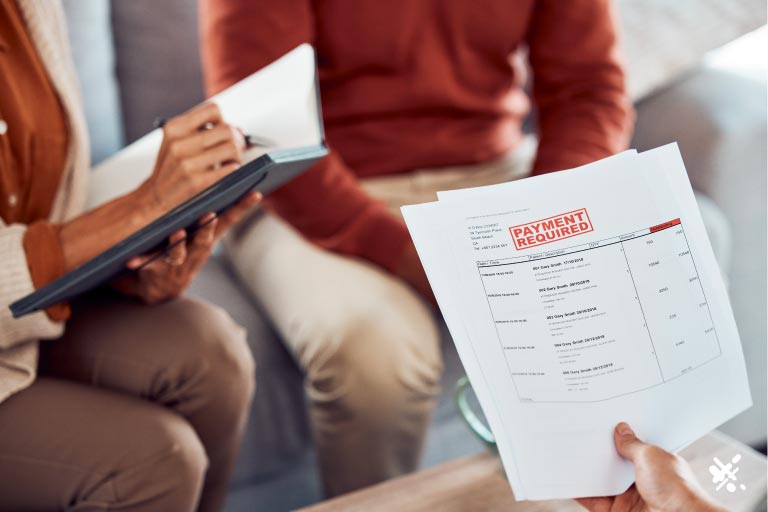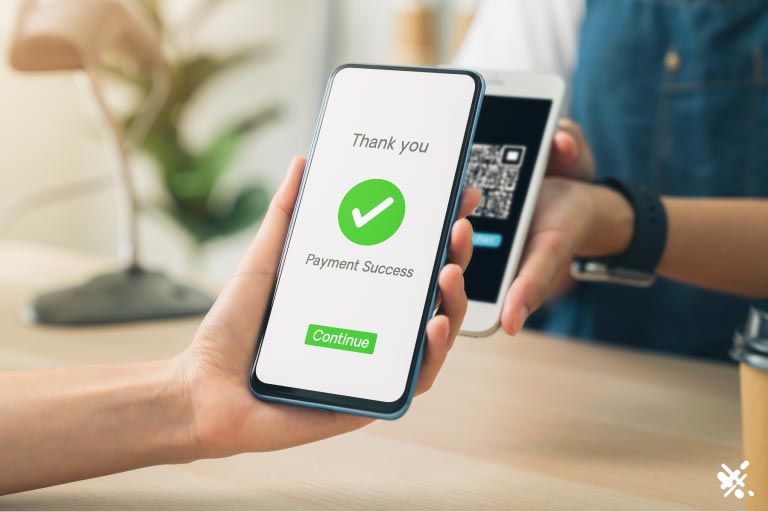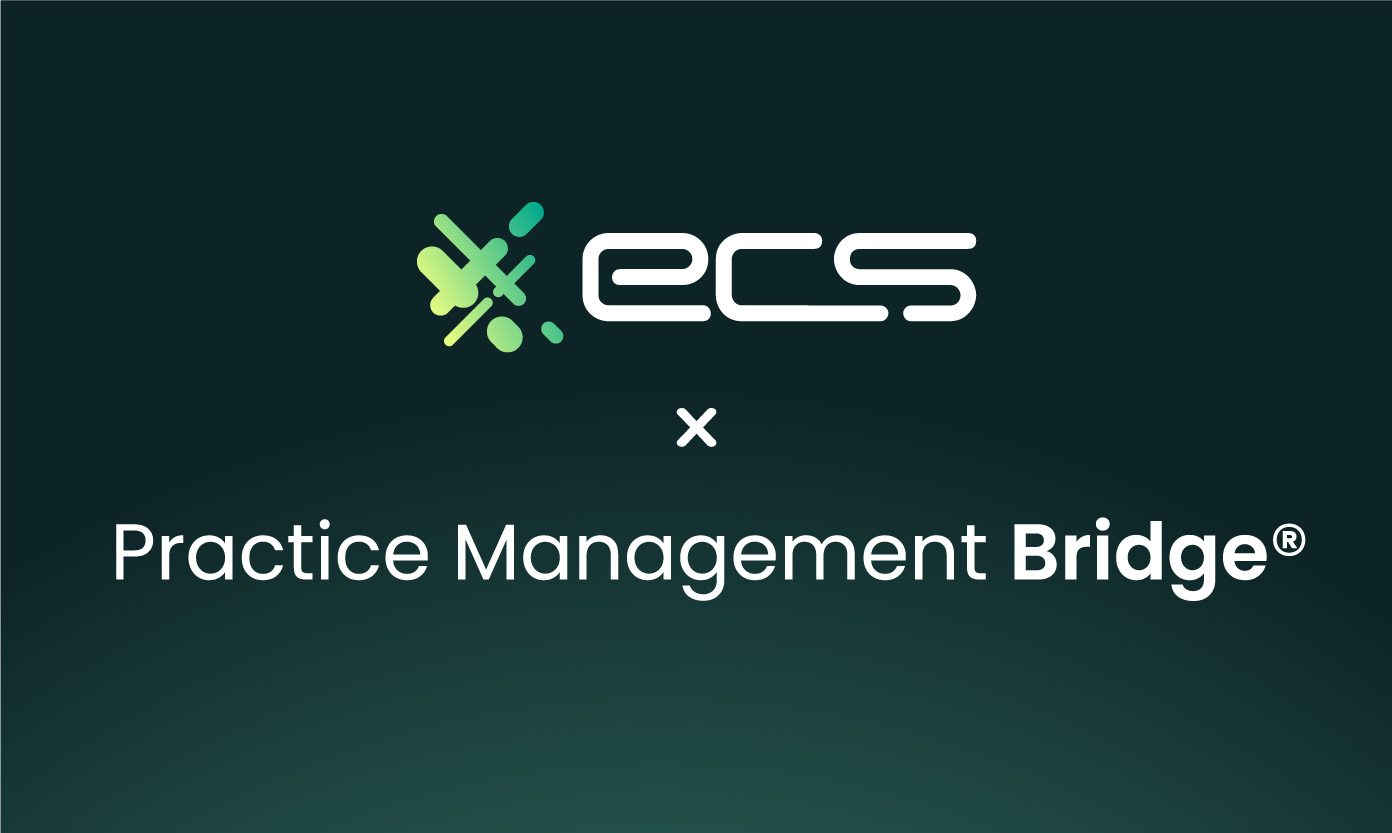ECS and Practice Management Bridge are entering an exciting partnership to create a practice management bridge for healthcare providers. One outstanding aspect of this partnership is how it will allow healthcare providers to collect payments and shrink their bad debt.
But there are many other exciting components to this partnership. As healthcare providers know, providing patient care is just one facet of being a provider. A whole side to the industry circulates around business concerns—like collecting payments.
The average doctor works 40-60 hours per week, and the average dentist is 35-40. And some healthcare practitioners may work more than 100 hours. Although there is a gradient of how much time practitioners spend on paperwork, it can be burdensome. For instance, while the typical therapist sees 25-30 patients each week, they might spend 10 hours on paperwork.
Some of this paperwork involves patient care. But some of it is just about accounting and billing. And if the care provider is not doing it themselves, they’re paying a receptionist. A streamlined patient management bridge can go a long way toward reducing the cost of collecting patients from payments. So that said, here are a few things ECS with Practice Management Bridge will offer:
- Point of Care Payments
- Online and Mobile Payments
- QR Codes on Paper Bills or In the Office
- Digital Patient Forms
- Patient Financing
- Payment Plans
- Card on File and Other Security Measures
As mentioned, bad debt is one of the biggest billing problems in the healthcare industry. This is largely due to a lack of a systematic approach for processing point-of-care payments—or effectively collecting post-care payments as part of a payment plan.

High Deductibles, Higher Out Of Pocket Costs
One significant source of this bad debt is the healthcare industry’s impact on patients’ finances. As recently as 2021, almost 60% of the domestic workforce was enrolled in a high-deductible health insurance plan. There is always a tradeoff between the deductible (and copays) and the monthly premiums—as one goes up, the other goes down.
Some policyholders have insurance through their workplace, while others pay for it out of pocket. Workplaces offering high deductible plans and consumers who purchase their own aim at the same target: lower monthly premiums. Either way, the result is a whopping $433 billion in out-of-pocket healthcare spending.
This is a significant dollar amount in a country of 340 million individuals. Patient sentiment reflects these numbers, with 65% of Americans worried about paying for medical surprises. And 40% of millennials (as one demographic example) were even willing to forego medical care due to the cost.
The average out-of-pocket healthcare cost per person hovers around $1,200. To create some additional perspective to situate that number, nearly 40% of polled Americans could not come up with $400 to cover any surprise expenses. There is no way to fudge these numbers: patients cannot afford medical surprises.
Out Of Pocket Costs Are Increasingly Unavoidable
And perhaps even more, unfortunately, medical surprises are unavoidable. This is not just a timeless truism but a statement on healthcare trends outside of a discussion of payment processing. Take a look at diabetes, for instance, which is referred to as one of the “silent killers.”
Example 1: The Cost of Diabetes in the U.S.
37 million adults—roughly 10% of the U.S. population—have diabetes. And shockingly, another 96 million are pre-diabetic, roughly 33% of the population. And even more shockingly, 80% of those adults with pre-diabetes do not even know they have it. Blindness, kidney failure, heart disease, stroke, and loss of limbs are all serious consequences of diabetes that will result in $327 billion in total medical costs and lost wages.
Before you start chugging beet juice (which has been linked to decreased risk of diabetes through clinical studies), let’s fortify our argument with a little more data.

Example 2: The Cost of Heart Disease in the U.S.
Hypertension (high blood pressure) is another generator of costly medical issues, and also very common, with over 103 million adults diagnosed. As you might expect, numbers increase with age. 22% of Americans aged 18 to 39 have it, 55% of those 40 to 59, and 75% of those 60 and older.
And before you blend some garlic into that aforementioned beet juice (garlic is strongly linked to lowering blood pressure in hypertensive subjects), let’s look at one more common issue: heart disease. This is the #1 killer in the United States, killing 647,000 Americans every year (to put that number in perspective, that’s four times the number of hotel rooms in Las Vegas). Around 20% of heart attacks are silent, which integrates with the surprisingly dismal statistic that more than 18 million Americans aged 20 and older already have heart disease.
The point of all this data is that American health is not trending in a positive direction. Medical issues are increasingly common, a trend that goes well with increasing financial difficulties. Wages are stagnant, debt is increasing, and medical costs are rising. Most consumers will inevitably have to face that surprise $1,200 out-of-pocket expense.
Patients Do Intend To Pay Their Bills
The thing is, patients are generally willing to pay their medical bills. But there are times when they feel that other bills may take precedence. And there are reasons why healthcare providers cannot collect this debt as easily as lenders can. Lenders typically have greater leverage over their borrowers. For instance, a bank can initiate foreclosure proceedings, and a vehicle lender can repossess the vehicle.
There is not much that healthcare providers can do other than send a debt to collections. And as it turns out, a lot of medical debt gets sent to collection agencies or written off as bad debt. There may be as much as $40 to $60 billion in healthcare bad debt accumulating per year.
For instance, the average bad debt for 4,500 hospitals across the U.S. is $11.5 million, and the 25 hospitals with the largest amounts of bad debt had an average bad debt of $85.5 million, comprising a bad debt ratio of nearly 72%. Can you imagine any other organization staying afloat with those kinds of numbers?
How Do Americans Feel About Their Medical Debt?
The biggest sources of medical debt are emergency room visits (39%) followed by doctor visits (28%), childbirth (22%), dental care (20%), lab fees (18%), and surgery (18%). In case you’re wondering about the overlap, many of the polled consumers had more than one source of medical debt.
Around 40% of adults have medical debt. Of those adults, 24% have past-due bills that they can’t pay. 21% are paying them off over time directly to a provider. 17% owe that debt to a collection agency or lender. Another 17% owe it to a credit card company. And around 10% owe it to a family member, which is probably more stressful than any of the above.
But as mentioned, patients do want to pay off these debts. Many of them may feel a particular moral obligation to do so since the debt was rendered in return for medical attention. However, the nature of the beast has become one in which Americans struggle to pay off their medical debts. They need better solutions for making manageable payments.
Without a systemized approach to taking down their debt, they may feel that they can’t pay it off—a sentiment that gains persuasiveness as the size of their debt increase. Of patients who owe less than $1,000 in medical debt, 63% are optimistic about paying it off. But among those who owe $10,000 or more, only 47% believe they can do it.

Paper Recordkeeping is Not Helping
The situation is only exacerbated by the state of record keeping and accounting in healthcare settings. Paper record-keeping may forever be immortalized in medical parlance (e.g., let’s pull your chart). But there is nothing sentimental about the cost of running a business on paper (that is, using paper for billing, communication, and recordkeeping).
Paper invoices may cost between $12 and $30 to process for just one invoice. While that sounds steep, keep in mind that cost also factors in the labor involved: a receptionist printing the bill, putting it in an envelope, and mailing it, for instance. But that is not the real cost we’d like to focus on.
The real cost is the tendency of paper billing to become a funnel to bad debt. As seen from the statistics above, bad debt is a serious problem in the healthcare industry. Hospitals can stave off bad debt ratios of 78% with some grants, government bailouts, and lots of fundraising. But that’s not something you can probably rely on as a smaller health practitioner.
The result of paper billing, increasing medical costs, and increasingly strapped consumers is that more and more bills are heading to collections.
Collections Agencies Are Not a Fix-All
Healthcare providers themselves typically do not report delinquent bills to credit bureaus. However, bills that go to collections can and are often reported. In fact, as recently as 2021, about 43 million consumers with unpaid medical bills showed up on their credit reports. Significant legal scaffolding has been set up to protect consumers from the impact of medical debt, making it harder to collect.
Yet another reason to do everything you can to avoid sending bills to collections. And another is the fees. Collection agencies can charge anywhere from 25% to 50% of the collected amount, which means the provider is still losing money. They may add fees on top of that, which creates an extremely frustrating and negative customer experience.
In conclusion, it’s important to realize that collections are not about getting your money back as much as about staunching the bleeding. You cannot rely on collections to save your cash flow. And it also drives patients away from your practice. A different solution is needed.
Practice Management Bridge and ECS
This is where Practice Management Bridge and ECS shine. Practice Management Bridge’s solutions are streamlining the medical billing process so you don’t have to send bills to collections or write off so much bad debt. The patient management bridge and payment gateway integrate perfectly with the EMR you already use.
Migrating patient data to a new electronic health recordkeeping system can be extremely frustrating. It’s probably one of the biggest objections that healthcare providers have to switching their healthcare payment gateway. But practitioners can rest assured that the healthcare software they’re already using can integrate with Practice Management Bridge’s suite of solutions.

Cutting Edge Point of Care Payments
The first area of improvement from the Practice Management Bridge with ECS is right in the office. The partnership brings payment processor solutions that are the most up-to-date with the merchant account industry. One of these payment solutions is the card reader.
More and more patients use digital wallets on their mobile phones to make contactless payments. They also use contactless credit and debit cards that require them to wave the card over the terminal. While mobile devices and contactless payments are relevant to all small businesses, they are particularly relevant to the healthcare industry.
Mastercard found that 82% of consumers view contactless payments as a cleaner transaction method. For a healthcare office, this seemingly small point sends a strong message to your patients that you take hygiene seriously.
The Importance of Patient (Customer) Experience
Practice Management Bridge and ECS also create an improved payment experience. For many practices, the old way of collecting copays was for the receptionist to collect the card, input the card number and other payment details on a dinosaur-era POS, and keep the patient waiting for half an hour while the receipt machine slowly, slowly spits out a miniature scroll inscribed with faint purple ink.
Of course, we are exaggerating about the timeframe, but anyone who has made a payment at the doctor’s or dentist’s office will tell you that the payment service does not seem “real-time.” By contrast, contactless transactions take two seconds or less to complete.
Customer experience may not seem so important in its long-term implications. But keep in mind that patients are not just making a “store payment.” They may need to present insurance information, fill out forms, and wait. Then, go back and wait some more. After all that, being asked to make a payment and having to wait for a long payment process is the icing on the cake (and it’s not a tasty cake). Quick, contactless payments provide a better conclusion to the visit.
Online and Mobile Payments
With ECS and Practice Management Bridge, you don’t need to collect payment immediately. You will have the option of presenting patients with options like Text to Pay and QR Payments. Some practitioners prefer this method of collecting payment for different reasons. They may be short-staffed, and receptionists don’t have time to process payments then and there. Or they may feel it creates a less pressuring experience.
Here’s how text-to-pay works: the patient receives a text reminder to make a payment. A payment link is sent as a text message. They can click on the link and be directed to a secure online payment gateway. While this method might seem unorthodox to established practitioners, it’s extremely effective and is already being leveraged as an enterprise solution by numerous large providers like hospital systems.
Text messages have a 209% higher open rate than other forms of communication, paper mailing included. Around 45% of consumers respond to “branded texts” or texts that are clearly from a business. Around 98% of said consumers open a text message within three minutes, which is much faster than getting a medical bill and tossing it into the “later” pile.
One of the main reasons that patients or consumers don’t pay bills is that they forget. Texts with a linked payment option are an effective way to overcome that problem. In fact, around 69% of polled consumers said they’d be more likely to pay on time if they texted their payment.

QR Codes on Paper Bills or In the Office
That’s big news for your practice. But text to pay is not the only at-home option for making payments. You can also present your patients with QR codes. QR codes are checkerboard patterns that customers can scan with their mobile phone camera. They are then directed to an online payment gateway where they can make their payment.
This is similar to the idea of text-to-pay in that they’re paying from a mobile device. However, it is different in that the customer needs to be involved in initiating the process (instead of receiving a text). However, you can also get the ball rolling by putting the QR code in front of them.
This can be done by placing the QR code on a paper bill. This may not sound motivating, given what we’ve said about paper billing. However, it does bridge the gap a little bit in that patients do not have to call somewhere (such as your office) to make a payment.
You can also place QR codes right in your waiting room. Large signage can present a QR code for patients to scan to make a mobile payment right from their phone. Ultimately, you can present patients with a combination of payment reminders: a QR code in the waiting room, paper mailings with QR codes, and text reminders.
Digital Patient Forms
Another solution from ECS and Practice Management Bridge is digital patient forms. Patients are routinely asked to fill out forms at the care provider’s office. Most patients dislike having to fill these forms out. Part of this is that they feel they’re being asked to repeat information that has already been or will be provided to the practitioner (or other practitioners). Part of it is that the forms are often paper attached to a clipboard in an era when most people don’t write anything by hand anymore.
Practice Management Bridge can provide your practice with digital forms to send to your patients. These patients can fill out the forms in the office on a tablet or phone. They can also fill them out at home before the visit. Pre-care forms can create a better experience for those patients who feel rushed having to fill forms out in the waiting room.
The digital patient forms and electronic health records can also be coupled with a payment authorization form. The payment authorization can be filled out pre-care, point-of-care, or post-care, giving the patient some flexibility. Many patients will appreciate the opportunity to fill out patient forms and authorize payment in the pre-care phase. This will get the payment “out of the way” and take a proverbial load off their shoulders.
Patient Financing
Another great opportunity Practice Management Bridge and ECS presents is patient financing and/or payment plans. Financing involves working with a lender to provide the healthcare provider with a lump sum upfront, while the patient becomes responsible for making payments to the lender. However, point-of-sale financing (as it’s called) is nothing like a credit card or loan.
Applications for financing can be started right inside the practice management bridge without turning to a third-party platform (like CareCredit). Other than individuals on the Terrorist Watch List, in open bankruptcy, or subject to a fraud alert, nearly everyone is approved. Unlike credit cards or personal loans, credit scores are irrelevant.
Multiple payment plans are presented within 30 seconds of application. If the patient enrolls in one of these plans, you do not need to do any collecting or reminding. Practice Management Bridge’s partner financier, HFD, handles everything. This is a huge win for the practice and for patients who would otherwise be unable to afford a procedure.

Payment Plans
As many as 63% of patients are interested in the idea of a payment plan. However, 30% of patients also leave a practice without paying. And 50% of those patients (who walked out) are less likely to pay their bills. These numbers indicate the need for an electronic system to implement the payment plan rather than sending paper bills.
In fact, 85% of consumers would prefer an electronic method over paper for making payments, and 66% of patients would even be willing to switch practices for that convenience. These numbers also indicate that patients are willing to make their payments if the payment process is easy.
By “payment plan,” we mean something different than the aforementioned patient financing. In this case, a payment plan is in-house, and your practice will have to collect the payments. However, Practice Management Bridge provides a more effective systematic approach to collecting from an electronic management system.
With Practice Management Bridge and ECS, you can customize the payment plan to work for you and the patient. You can send text, email, and paper reminders about upcoming payments. Moreover, with pre-authorization forms, you can “keep” cards on file for recurring payments. Keep in mind that these reminders and communications are HIPAA-compliant to retain patient privacy and dignity.
Card on File and Other Security Measures
Keeping a card on file requires some compliance measures. The overarching concern is PCI DSS or Payment Card Industry Data Security Standards. These are standard and operational procedures businesses must follow for card networks and banks to allow them to accept credit and debit card payments.
Many sub-categories of PCI DSS are difficult or cost-prohibitive for businesses to implement. The best way for most businesses (healthcare practices included) to do so is to outsource PCI DSS to their practice bridge provider. Practice Management Bridge covers this as well, with the most up-to-date PCI compliance standards.
One way that Practice Management Bridge does this is with P2P encryption (point-to-point encryption or P2PE). Only around a dozen healthcare payment providers provide true P2P encryption for their customers (to give you a sense of that number, know that Visa estimates there are 1,300 different payment processing companies worldwide).
Without getting too technical, point-to-point encryption means that the customer payment data stays encrypted from the time it “leaves” the customer’s card (e.g., they insert the chip or hover it over the terminal) until the payment processor receives it.
In other words, while the payment info is “in transit,” it is warped into meaningless code that a third party cannot decipher. P2PE is considered the “gold standard” for avoiding data breaches during the payment process.
So, How Can ECS and Practice Management Bridge Benefit Me?
Now, let’s bring it home. Practice Management Bridge’s internal metrics gauged significant improvement among providers. They saw a 20% reduction in time spent managing billing, 30% in collecting and posting payments, 25% in payment reconciliation, and 90% in processing manual refunds.
There was a 33% reduction in paper statements and an average of one external system displaced (e.g., the provider could eliminate at least one unnecessary system from their operations). There was also an average 5% increase in payment collection, which could result in thousands or tens of thousands of dollars for the practice.
Of course, one of the more “intangible” or “unquantifiable” benefits of a good practice management bridge is how it frees up practitioners to focus on patient care. It’s unlikely that any care provider gets into medicine, dentistry, or their particular specialization to get into billing and collecting payments. Streamlining these processes allows them to focus on doing what is meaningful: patient care.
To learn more about what Practice Management Bridge and ECS can do, contact us to set up a demo and learn more about your specific practice.
